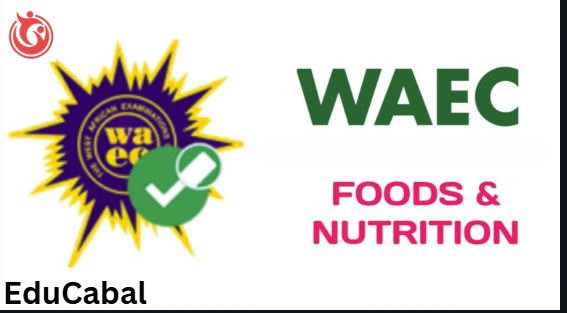
WAEC 2025/2026 Food And Nutrition Runz – As the WAEC 2025/2026 examination season approaches, many students are actively seeking verified help for their Food and Nutrition paper. Whether you’re preparing for the practical or theory exam, securing accurate and reliable runz (questions and answers) can greatly boost your confidence and ensure excellent results. In this detailed post, we explore everything you need to know about WAEC Food and Nutrition runz, how to get them, what to expect in the exam, and how to prepare smartly and legally.
WAEC 2025/2026 Food And Nutrition Runz
In our modern world, the intersection of healthcare, food sourcing, and consumer behavior presents vital insights for public health, sustainability, and marketing. In this article, we explore three interconnected topics:
-
Situations where personal health information may be collected.
-
The impact of research on the benefits of locally grown food.
-
The role of emotional and psychological cues in marketing.
(5a) Understanding When and Why Health Information May Be Collected
Access to health information can be critical in various scenarios, especially during emergencies or when a patient cannot communicate their medical history.
(i) Emergency Situations and Relatives’ Input
During emergencies, immediate access to accurate health information can save lives. If a patient is unconscious or severely injured, healthcare professionals may rely on information provided by relatives to make quick decisions.
(ii) Collecting Information from Parents, Guardians, or Relatives
When treating children or adults who lack mental capacity, consent and information must often come from a parent, guardian, or relative. This ensures that the medical care provided is accurate and appropriate for the individual’s needs.
(iii) Pathologist and Referring Providers
In diagnostic settings, a pathologist may need both specimens and detailed medical information from the referring provider. This collaborative approach improves diagnostic accuracy and patient care outcomes.
(5b) The Importance of Research on Locally Grown Food
Research on local food systems helps us understand how these choices impact health, the economy, and the planet.
(i) Local Food Is Full of Flavor
Locally grown produce is often fresher and harvested at peak ripeness, making it more flavorful than mass-produced food shipped from afar.
(ii) Local Food Has More Nutrients
Because local food spends less time in transport, it retains more nutrients. Fresh fruits and vegetables lose vitamins over time, so consuming them soon after harvest provides greater nutritional benefits.
(iii) Local Food Supports the Local Economy
Buying from local farmers and producers keeps money within the community. It strengthens regional agriculture, creates jobs, and supports small businesses.
(iv) Local Food Benefits the Environment
Local food reduces the need for long-distance transportation, which cuts down on carbon emissions. It also encourages sustainable farming practices and biodiversity.
(6a) The Role of Negative Emotional Cues in Marketing
Marketers often use psychological tactics to influence consumers. Negative emotions can play a surprisingly strong role in how people make decisions.
(i) High-Intensity Negative Pre-Processing Moods
Intense emotions like fear or anxiety can influence people to make impulsive decisions. Advertisers may use these emotions to push urgency—such as warning about health risks or environmental dangers.
(ii) Moderate-Intensity Negative Moods
More subtle negative feelings, like concern or guilt, can also sway decisions. These emotions might be used in campaigns about food waste, climate change, or personal health.
(iii) Influence of Non-Attribute and Attribute Information
Sometimes marketing uses emotional cues unrelated to the product’s features (non-attribute), or it enhances real features (attribute) to create a positive or negative impression. For example, showing sick children in an ad for healthy food can link the product with a desire to nurture and protect.
FAQs
Q1: Why is health information sometimes collected from relatives?
A: In emergencies or when a patient lacks capacity, relatives can provide vital health details that aid quick and accurate treatment.
Q2: Is local food really healthier than imported food?
A: Yes, it often contains more nutrients due to reduced transportation time and is usually fresher.
Q3: How do emotions affect buying decisions?
A: Emotional states, especially negative ones, can drive urgency and influence preferences, often without consumers realizing it.
Conclusion
Understanding how health information is gathered, the benefits of local food, and the influence of emotions on consumer behavior equips us to make better personal and community choices. Whether you’re a healthcare worker, consumer, or marketer, these insights help build healthier lives and more resilient communities.





